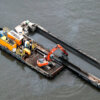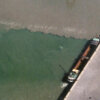Flood defence aims to protect low-lying communities close to oceans and rivers from sudden storms and floods.
Storm surge prevention
The best way to approach flood defence is by establishing systems, which try to assess the predictability of major storm events which can cause flooding.
Storm surge barriers such as the Eastern Scheldt barrier, the Maeslantkering, and the Thames Barrier, have been constructed by the dredging industry under the careful guidance of the respective governments.
The construction of the Eastern Scheldt and Maeslantkering was the beginning and the end of a massive coastal protection plan called the Delta Works, which was undertaken by the Netherlands government to protect the low-lying country.
The Thames Barrier similarly was built downstream of central London to prevent the as much as possible of Greater London from being flooded by exceptionally high tides and storm surges coming up river from the North Sea.
In Belgium, the Sigma Plan offers protection against storm surges as well as floods caused by excessive rainfall, with the additional objective to protect nature and navigation. The plan protects approximately many thousand hectares of land in Belgium bordering the Scheldt River and its tributaries. The plan combines so-called grey infrastructure measures, such as strengthened dykes, with green measures, which provide grids of controlled flood areas.
River training works
In areas where seasonal and tidal expansion of rivers occurs, river training systems can improve the pattern of the river’s course and limit flood damage.
River training offers structural measures to improve a river and reinforce its banks. It is an important component in general flood control as well as in the prevention and mitigation of flash floods. It can also ensure that even during a flood, the river’s waters will remain within its banks and continue to flow under a bridge.
A variety of methods are used by dredgers to strengthen embankments and dykes, and compensate for erosion, so that a river can be guided in its proper course. This will help avoid unfavourable meandering or spilling over its banks or into smaller branches, which cannot handle overflows. River training works can have a significant role in ensuring the safety of people from floods.


































